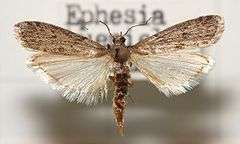Mediterranean flour moth
| Mediterranean flour moth | |
|---|---|
 | |
| Not evaluated (IUCN 3.1) | |
| Scientific classification | |
| Kingdom: | Animalia |
| Phylum: | Arthropoda |
| Class: | Insecta |
| Order: | Lepidoptera |
| Family: | Pyralidae |
| Tribe: | Phycitini |
| Genus: | Ephestia |
| Species: | E. kuehniella |
| Binomial name | |
| Ephestia kuehniella Zeller, 1879 | |
| Synonyms | |
| |
The Mediterranean flour moth, Indian flour moth or mill moth (Ephestia kuehniella) is a moth of the family Pyralidae. It is a common pest of dry plant produce – especially cereals – and found around the world.
Another common name, less unambiguous, is "flour moth", which (like "pantry moth", occasionally used for the present species) may also refer to the related Indianmeal moth (Plodia interpunctella). In addition, the species has been discussed under a number of now-invalid junior synonyms, its specific name has been frequently misspelled, and it was once placed in a distinct genus Anagasta (now considered a subgenus of Ephestia).
Description and ecology
The adult moth is pale gray and up to 12 mm long, with dark bands.[1] The hindwings are grayish-white.[2] The wingspan is between 16 mm and 20 mm. The larva (caterpillar) is off-white with a darker head and small black spots on its body.[1] The larva emerge from tube-like structures about 7 days after they hatch.[1] The larva is about 12 mm long when mature. The larva then find a place to spin a cocoon.[1] When the larva spin cocoons, they turn to a reddish-brown color.[1] It takes about 8–12 days for the larva to become a moth and it takes 2–4 weeks for the egg to become an adult.[1] The female moth lays 120–680 small white eggs.[1] These eggs commonly attach to food and they hatch within 3–8 days.[1]
The caterpillars are often found feeding on flour, cereals, baked goods and other dry grain products in food storage areas.[1] Less often, dried fruits or mushrooms and even peat or rotting wood may be eaten. The species may reach extreme population densities in suitable locations (such as gristmills) if left uncontrolled, and the silken webs produced by the caterpillars may even interfere with normal operations of machinery such as flour sieves.[3] The adult moths do not feed.[4]
Pest control
As with most grain- or flour-feeding pests, the most effective method of control is to adopt basic good sanitary practices. Clean all infested surfaces with white vinegar.[5]
One way to keep the moths away is to place bay leaves in the food containers along with the original grains. Products already affected should still be thrown away.
It is essential to ensure that food storage areas are kept clean and tidy and that no residues are left over. In addition it is imperative that food – especially grain, sugar and flour – is kept in plastic or metal storage containers with tight fitting lids. This will stop flour moths and other pests from getting at their contents. Note however that tiny gaps, even at the rim of Tupperware lids, will allow oviposition.
Use in laboratory
This moth is easy to rear and has been used in entomological laboratories as a source of eggs for feeding other species, such as Orius niger.[6]
Gallery
 Female, dorsal view
Female, dorsal view Female, ventral view
Female, ventral view Male, dorsal view
Male, dorsal view Male, ventral view
Male, ventral view Larva
Larva
References
- 1 2 3 4 5 6 7 8 9 Steve Jacobs and Dennis Calvin (October 1988). "Mediterranean Flour Moth". Penn State College of Agricultural Sciences. Retrieved 2013-09-07.
- ↑ Jay B. Karren and Alan H. Roe (May 2000). "Flour Moths, Fact Sheet No. 1" (PDF). Retrieved 2013-09-07.
- ↑ Grabe (1942)
- ↑ Vera Krischik and Wendell Burkholder. "Mediterranean Flour Moth (Mill Moth)". Retrieved 2013-09-07.
- ↑ Mary Schmich (2013-03-022). "Attack of the pantry moths". Chicago Tribune. Retrieved 2013-09-07. Check date values in:
|date=(help) - ↑ Jean-Lou Justine (1978) [Contribution to the study of the influence of alimentation on the development and reproduction of Orius niger Wolff, 1811 (Heteroptera: Anthocoridae)] Contribution à l'étude de l'influence de l'alimentation sur le développement et la reproduction d'Orius niger Wolff, 1811 (Heteroptera : Anthocoridae). Masters Thesis, University of Montpellier, Montpellier, France, 92 pages [in French with English abstract] doi:10.6084/m9.figshare.155299

Additional reading
- Grabe, Albert (1942): Eigenartige Geschmacksrichtungen bei Kleinschmetterlingsraupen ["Strange tastes among micromoth caterpillars"]. Zeitschrift des Wiener Entomologen-Vereins 27: 105-109 [in German]. PDF fulltext
- Savela, Markku (2009): Markku Savela's Lepidoptera and some other life forms – Ephestia elutella. Version of 2009-APR-25. Retrieved 2010-APR-10.
External links
![]() Media related to Ephestia kuehniella at Wikimedia Commons
Media related to Ephestia kuehniella at Wikimedia Commons